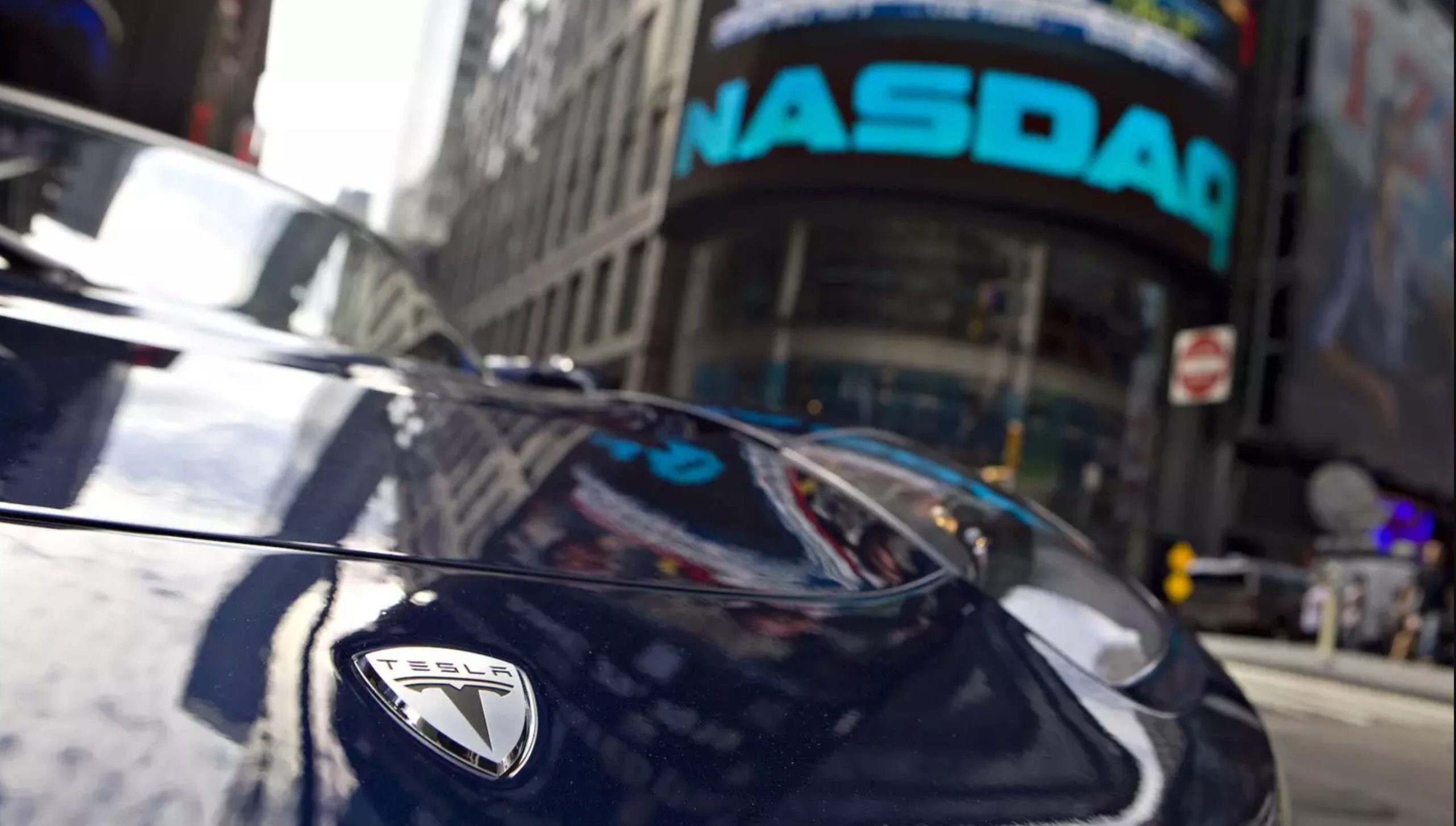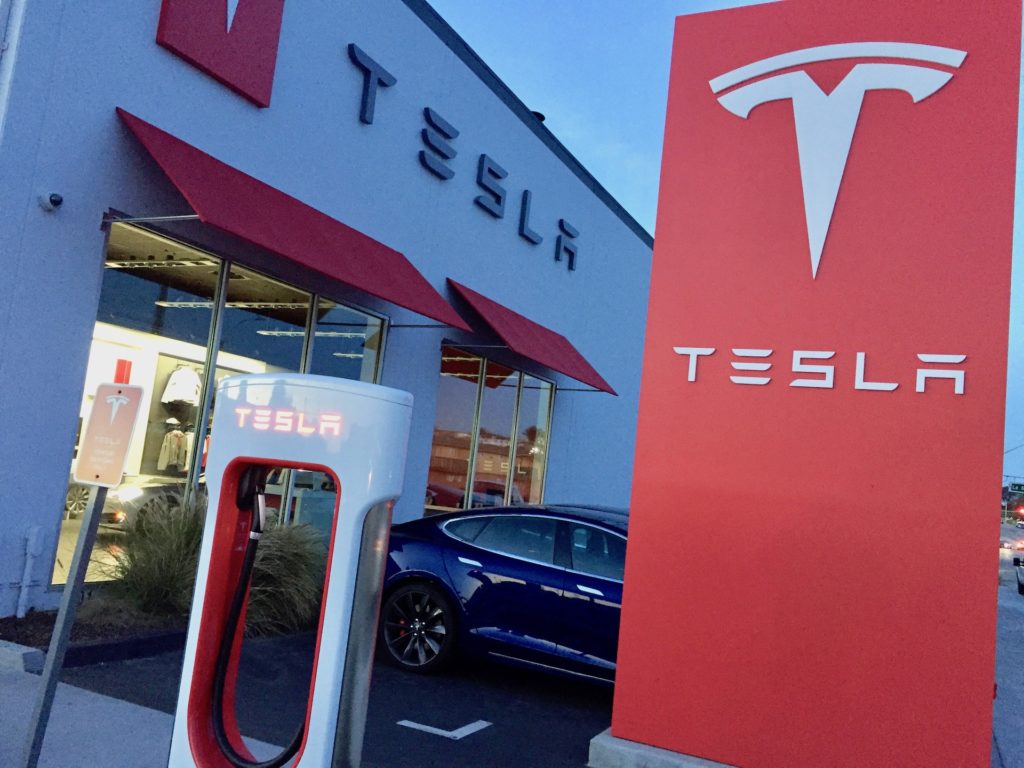

Energy
Tesla (TSLA) went from IPO to beating Ford in value in just seven years
The story of Tesla is a fascinating one by any measure: a group of Silicon Valley entrepreneurs get together to start a car company, a feat that business-school professors have been using as the definition of economic impossibility for decades, and after only a few years they build a company that rivals the Big Three, and a car that earns every accolade the industry has to offer. Of course, there are several near-death experiences along the way to hold our interest.
This stranger-than-fiction story has been told in various videos and one full-length book, and pieces of it have been told in thousands of print and online articles. For those who prefer a quick, easy-to-digest format, Global Energy Metals has summarized the Tesla story in a large infographic, which comes to us courtesy of Visual Capitalist.
The Tesla saga began with the low-volume Roadster, but the startup became “a real company” with its 2010 initial public stock offering (IPO), which raised some $226 million in capital and started what was to be a stomach-churning roller-coaster ride of growth.
Tesla was the first American car company to make an IPO since Ford went public in 1956.

Tesla Store, Service Center and Supercharger station in Monterey, CA [Photo: Teslarati]
Ford was already a large and well-known company at the time, and its IPO was the largest in Wall Street’s history. In contrast, Tesla in 2010 was a tiny niche automaker that few outside the auto industry or the environmental community had heard of.
Stock market analysts were skeptical, to say the least, and short sellers (speculators who place bets that a company’s stock will decline in price) flocked to the stock (the short interest in Tesla continues to be huge, despite the fact that the shorts have lost billions).
Despite the wild gyrations that are typical of a high-flying tech stock, the trend for TSLA has been ever upward. A mere seven years after its IPO, Tesla’s market value had surpassed Ford’s, despite the fact that the older company’s sales volume is many times greater. As of the end of 2017, Ford’s stock market capitalization was $49.9 billion, while Tesla’s had reached $52.3 billion.
A tremendous amount happened in those seven years. Tesla acquired its massive Fremont factory in a sweetheart deal with Toyota. It discontinued the Roadster and moved on to the second phase of its master plan, building two native EVs, the now-famous Model S and Model X. The two vehicles went on to win just about every award and accolade in existence, including being recognized as the “safest car ever tested” by the NHTSA and the “best car ever tested” by Consumer Reports. Over 200,000 units have been sold to date.
With partner Panasonic, Tesla built its gargantuan Gigafactory in Nevada, with the objective of reducing the cost of lithium-ion battery packs by 30%. Tesla introduced the Powerwall, a key piece of the puzzle of electric vehicles and home solar energy generation. It introduced Autopilot technology and built out its worldwide Supercharger network.
In 2016, Tesla announced the culmination of its master plan: Model 3, a mid-priced EV for the mass market. The new EV quickly racked up almost half a million pre-orders, making it arguably the most successful product launch in history.
With Model 3 now showing up on roads around the country, Elon Musk has achieved the quixotic goal that he set over a decade ago. However, the Tesla story is just beginning: in the pipeline are the Tesla Semi, a new Roadster, solar roof tiles, massive energy storage projects in Australia, Puerto Rico and elsewhere, loads more Superchargers and all kinds of nifty new features, delivered via over-the-air software updates. The future for Tesla, and for those of us who write about it, looks as bright as the California sun.
Infographic

===
Note: Article originally published on evannex.com, by Charles Morris
Infographic: Visual Capitalist

Cybertruck
Tesla updates Cybertruck owners about key Powershare feature

Tesla is updating Cybertruck owners on its timeline of a massive feature that has yet to ship: Powershare with Powerwall.
Powershare is a bidirectional charging feature exclusive to Cybertruck, which allows the vehicle’s battery to act as a portable power source for homes, appliances, tools, other EVs, and more. It was announced in late 2023 as part of Tesla’s push into vehicle-to-everything energy sharing, and acting as a giant portable charger is the main advantage, as it can provide backup power during outages.
Cybertruck’s Powershare system supports both vehicle-to-load (V2L) and vehicle-to-home (V2H), making it flexible and well-rounded for a variety of applications.
However, even though the feature was promised with Cybertruck, it has yet to be shipped to vehicles. Tesla communicated with owners through email recently regarding Powershare with Powerwall, which essentially has the pickup act as an extended battery.
Powerwall discharge would be prioritized before tapping into the truck’s larger pack.
However, Tesla is still working on getting the feature out to owners, an email said:
“We’re writing to let you know that the Powershare with Powerwall feature is still in development and is now scheduled for release in mid-2026.
This new release date gives us additional time to design and test this feature, ensuring its ability to communicate and optimize energy sharing between your vehicle and many configurations and generations of Powerwall. We are also using this time to develop additional Powershare features that will help us continue to accelerate the world’s transition to sustainable energy.”
Owners have expressed some real disappointment in Tesla’s continuous delays in releasing the feature, as it was expected to be released by late 2024, but now has been pushed back several times to mid-2026, according to the email.
Foundation Series Cybertruck buyers paid extra, expecting the feature to be rolled out with their vehicle upon pickup.
Cybertruck’s Lead Engineer, Wes Morrill, even commented on the holdup:
As a Cybertruck owner who also has Powerwall, I empathize with the disappointed comments.
To their credit, the team has delivered powershare functionality to Cybertruck customers who otherwise have no backup with development of the powershare gateway. As well as those with solar…
— Wes (@wmorrill3) December 12, 2025
He said that “it turned out to be much harder than anticipated to make powershare work seamlessly with existing Powerwalls through existing wall connectors. Two grid-forming devices need to negotiate who will form and who will follow, depending on the state of charge of each, and they need to do this without a network and through multiple generations of hardware, and test and validate this process through rigorous certifications to ensure grid safety.”
It’s nice to see the transparency, but it is justified for some Cybertruck owners to feel like they’ve been bait-and-switched.
Energy
Tesla starts hiring efforts for Texas Megafactory
Tesla’s Brookshire site is expected to produce 10,000 Megapacks annually, equal to 40 gigawatt hours of energy storage.

Tesla has officially begun hiring for its new $200 million Megafactory in Brookshire, Texas, a manufacturing hub expected to employ 1,500 people by 2028. The facility, which will build Tesla’s grid-scale Megapack batteries, is part of the company’s growing energy storage footprint.
Tesla’s hiring efforts for the Texas Megafactory are hinted at by the job openings currently active on the company’s Careers website.
Tesla’s Texas Megafactory
Tesla’s Brookshire site is expected to produce 10,000 Megapacks annually, equal to 40 gigawatt hours of energy storage, similar to the Lathrop Megafactory in California. Tesla’s Careers website currently lists over 30 job openings for the site, from engineers, welders, and project managers. Each of the openings is listed for Brookshire, Texas.
The company has leased two buildings in Empire West Business Park, with over $194 million in combined property and equipment investment. Tesla’s agreement with Waller County includes a 60% property tax abatement, contingent on meeting employment benchmarks: 375 jobs by 2026, 750 by 2027, and 1,500 by 2028, as noted in a report from the Houston Business Journal. Tesla is required to employ at least 1,500 workers in the facility through the rest of the 10-year abatement period.
Tesla’s clean energy boom
City officials have stated that Tesla’s arrival marks a turning point for the Texas city, as it highlights a shift from logistics to advanced clean energy manufacturing. Ramiro Bautista from Brookshire’s economic development office, highlighted this in a comment to the Journal.
“(Tesla) has great-paying jobs. Not just that, but the advanced manufacturing (and) clean energy is coming to the area,” he said. “So it’s not just your normal logistics manufacturing. This is advanced manufacturing coming to this area, and this brings a different type of job and investment into the local economy.”
Energy
Tesla and Samsung SDI in talks over new US battery storage deal: report
The update was related by industry sources and initially reported by South Korean news outlets.

Recent reports have suggested that Tesla and Samsung SDI are in talks over a potential partnership to supply batteries for large-scale energy storage systems (ESS).
The update was related by industry sources and initially reported by South Korean news outlets.
ESS batteries to be built at Samsung’s Indiana plant
As noted in a report from Korea JoongAng Daily, the demand for energy storage systems has been growing rapidly in North America, thanks in no small part to the surge in AI investments across numerous companies. With this in mind, Tesla has reportedly approached Samsung SDI about a potential battery supply deal.
The deal is reportedly worth over 3 trillion Korean won (approximately $2.11 billion) and will span three years, according to The Korea Global Economic Daily. A battery supply deal with Samsung SDI could make sense for Tesla as the company already has a grid-scale battery, the Megapack, which is perfect for industrial use. Samsung SDI could simply supply cells for the EV maker.
Production of the batteries would reportedly take place at Samsung SDI’s joint venture factory with Stellantis in Indiana, which is currently under construction. Samsung SDI recently announced plans to use part of that plant’s EV lines to produce cells for ESS, with a targeted capacity of 30 GWh by the end of next year.
Tesla and Samsung’s partnership
At present, only a handful of manufacturers, including Korea’s LG Energy Solution, Samsung SDI, SK On, and Japan’s Panasonic, are capable of producing energy storage-scale batteries domestically in the United States. A Samsung SDI official issued a comment about the matter, stating, “Nothing has been finalized regarding cooperation with Tesla.”
The possible energy storage system deal adds another layer to Tesla’s growing collaboration with Samsung, which is already in line as a partner in the upcoming production of Tesla’s AI5 and AI6 chips. Early sample manufacturing of the AI6 is expected to begin in South Korea, with mass production slated for Samsung’s Texas-based Taylor foundry when it starts operations.
The AI6 chip will power Tesla’s next wave of high-volume projects, including the Optimus humanoid robot and the autonomous Cybercab service. Musk has called the partnership with Samsung a “real collaboration,” adding that he personally plans to “walk the line” at the Taylor facility to speed up progress.








